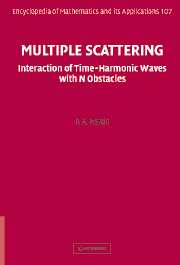Book contents
- Frontmatter
- Contents
- Preface
- 1 Introduction
- 2 Addition theorems in two dimensions
- 3 Addition theorems in three dimensions
- 4 Methods based on separation of variables
- 5 Integral equation methods, I: basic theory and applications
- 6 Integral equation methods, II: further results and applications
- 7 Null-field and T-matrix methods
- 8 Approximations
- Appendices
- References
- Citation index
- Subject index
4 - Methods based on separation of variables
Published online by Cambridge University Press: 06 July 2010
- Frontmatter
- Contents
- Preface
- 1 Introduction
- 2 Addition theorems in two dimensions
- 3 Addition theorems in three dimensions
- 4 Methods based on separation of variables
- 5 Integral equation methods, I: basic theory and applications
- 6 Integral equation methods, II: further results and applications
- 7 Null-field and T-matrix methods
- 8 Approximations
- Appendices
- References
- Citation index
- Subject index
Summary
Today, the separation of variables derivations … are only of academic interest.
(Burke & Twersky [163, p. 501])Introduction
The method of separation of variables can be used to study acoustic scattering by a single obstacle, provided its surface coincides with a coordinate surface. In fact, the Helmholtz equation separates in eleven three-dimensional coordinate systems; see [41] for a review. Of these eleven, only six are useful for bounded obstacles: circles and ellipses in two dimensions; spheres, prolate spheroids, oblate spheroids and ellipsoids in three dimensions.
For two, or more, obstacles, we can proceed by combining separable solutions appropriate to each obstacle with an appropriate addition theorem. This method was used by Záviŝka in 1913 [1372] for two-dimensional scattering by circular cylinders. It is exact, and leads to an infinite system of simultaneous algebraic equations.
Despite the opening quotation (from 1964), the method is widely used, probably because it is both conceptually simple and numerically effective. Consequently, we give a detailed derivation for acoustic scattering by several circular cylinders and by several spheres, and then we discuss various extensions of the method.
Separation of variables for one circular cylinder
Consider a circular cylinder of radius a. Choose Cartesian coordinates (x, y), with the origin O at the centre of a typical cross-section, and plane polar coordinates (r, θ), so that x = r cos θ and y = r sin θ.
- Type
- Chapter
- Information
- Multiple ScatteringInteraction of Time-Harmonic Waves with N Obstacles, pp. 122 - 151Publisher: Cambridge University PressPrint publication year: 2006



